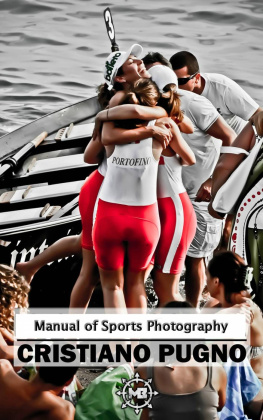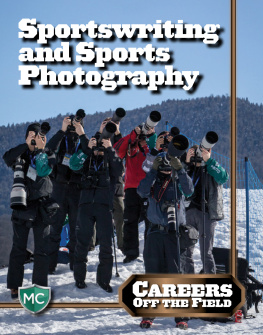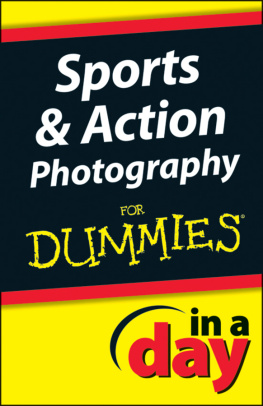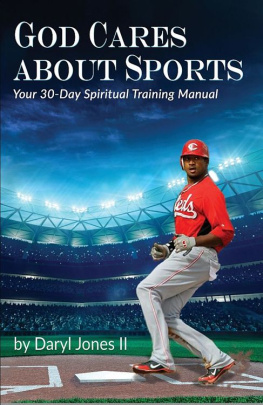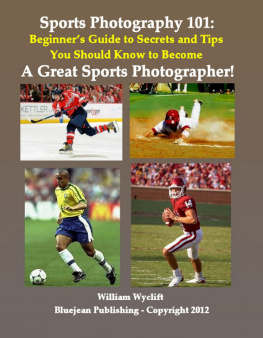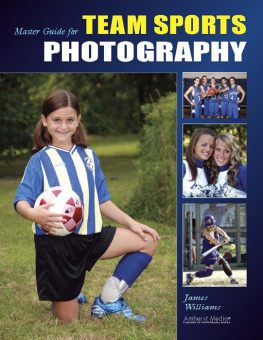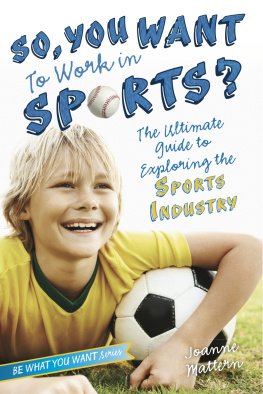Manual of Sports Photography
cristiano pugno
Translated by E.S. Dempsey
Manual of Sports Photography
Written By cristiano pugno
Copyright 2015 cristiano pugno
All rights reserved
Distributed by Babelcube, Inc.
www.babelcube.com
Translated by E.S. Dempsey
Cover Design 2015 cristiano pugno
Babelcube Books and Babelcube are trademarks of Babelcube Inc.
Manual of
Sports
Photography
Preface
This manual is intended to be a compilation of the author's experiences in the field of sports photography, and it is not necessarily the final word on the subject.
It is designed to be a guide for those who venture into this very specialized area of photography, with rules that are perhaps different from the general norm.
In the first part the reader will find guidelines applicable to all sports photography, while the second part contains more specific rules for various sports.
I have not included a lot of photos in this book because the display on e-readers cannot do justice to the images, and numerous photos would lengthen the download time. Also, it is beyond the scope of this book to be a commentary on my work.
You can follow my blog at:
http://beppeiaf.altervista.org/blog
Or email me at:
G ENERAL RULES
The most important thing is your safety!
B efore you shoot, look around and keep this in mind: Dont put yourself in danger, and don't endanger others with your behavior.
This is especially true in motor sports such as rallying and circuit races. If some areas are restricted from the public, it is definitely for reasons of safety. Even if you were able take photos, it would not be worth risking your life.
The same goes for photographers who venture into the mountains. If you are not properly trained and equipped, do not go into inaccessible areas. Otherwise, rescue workers may have to risk their lives to save you.
The main thing is the sport
not the photo!
Do not disturb the athletes! If flash is not permitted, do NOT use it. If there are other photographers who also have to work, give them enough space and don't move in front of them. If there are spectators (who may have paid to see the event), move around so you dont prevent them from seeing the competition.
One situation is not the same
as the next!
F orget about the software that runs on your SLR. Think with your head and figure out what you want and what you see in front of you.
Knowing the sport that you photograph helps, but its
not indispensable
To have practiced the sport that you want to photograph or at least know about it helps you to understand the important moments, errors or fouls. It also allows you to be ready the second before you need to get a good shot.
If you know soccer, you can probably bet your telephoto lens where the ball will end up after the cross. If you are experienced with gymnastics, you will know where the athlete will land after a jump and you'll be ready to take the shot. Knowing a sport makes it possible to eliminate photos that show a wrong move or a foul.
If you have never practiced a certain sport or don't know anything about it, research it before photographing it! Study it and look at photographs done by the masters; it's easy now with the Internet.
Normally, shoot with shutter priority (S) or manual (M), depending on the light conditions
This isnt for every situation so take it case by case, but remember that in sports photography it is fundamental to use a shutter speed fast enough to freeze the action and capture the details. However, if the light conditions are changeable and unpredictable, the automatic setting is certainly faster than you trying to manually adapt to the new light conditions.
The modern DSLR also has an optional automated ISO setting. Keep that in mind, especially when the light is low.
Time flies in sports
There are faster sports and slower sports. A cyclist trudging uphill is not as fast as a skier or a tennis player.
Experiment with your settings because in the same discipline it's possible to have faster action from the professionals than from the amateurs.
Sport lives in the moment
Make use of the burst setting to capture a special moment, and stay ready with your finger over the shutter release. Develop the skill of automatically shooting first before thinking about it.
Seeing that digital costs nothing, shoot! Better to throw out useless images than lose the action highlights. Watch out for what happens afterwards. After the ball has crossed the goal, don't miss the celebrations of the players and the fans. When goals are made, immortalize the joy or disappointment of the athletes at the result.
Remember the white balance
When shooting in RAW mode, the white balance is usually adjusted later in the conversion phase. But in sports there will be many occasions when you shoot jpeg format, and that is why you must remember to check the white balance. You can use the preset values in the camera or, especially when there are artificial lights, focus on a sheet of white paper to make a custom setting.
Dont demonize the backlight
In general try to avoid backlit shots, but if you're desperate you can shoot with flash to lighten shadow areas, since you wont have time to put up reflector panels or anything else.
Think about EVERYTHING
in the frame
W hen you click the shutter release, think about EVERYTHING in the frame, including what is behind the subject, whether you want it in the shot or not. If you shoot for publication, remember that the newspaper probably will only want those horizontal or vertical photos that fit into the space available on the page. Plan accordingly, or if you have been requested to take horizontal photos, forget about rotating the camera for portrait shots.
The viewfinder doesnt always
have the answer
In certain sports, such as skiing or boxing, the differences in brightness are huge, or there are light sources in the frame. Check how the automatic setting is working and don't be afraid to switch it to the 'semi-spot' meter setting to better define the image.
Stand out!
If all your photographs are taken from the same vantage point, they'll all look like the same photo. Try to move around, always without risk, and look for a new and unusual perspective. Your photo could be the winner over all the others.
Color is important but dare to be different
Sports photography is by definition done in color, but there are some cases where you can dare to photograph in black and white. Remember that if you convert a photo into black and white, all attention will be on the action, so the picture must be perfect.
Photograph regardless of the weather
If you shoot at a sporting event, you have to anticipate that it can get cold or rain, so first check the weather, then bring the right clothing.
Remember that your camera is more important than you, so cover it and protect it.
If bad weather catches you by surprise, cover your equipment with a plastic bag or plastic wrap.
Bring appropriate clothing for the cold, including a hat and gloves, and remember to keep spare batteries warm in a pocket of your jacket.
The job isnt finished after
getting the shot
Digital photography is not like analog, where the work is finished when you turn over the film! Now there is much more to do: you have to download files, select shots, insert the info file, do some minimum post-production, and then send it all to your client. And there will be occasions when you will have to do this on location.
So remember your notebook battery, the password for Internet access, your cable wires and card readers. When you remove a memory card from your camera, replace it immediately with another in order to always have a card ready. Delete photos only when you have TWO copies; or, bring multiple memory cards!
Next page
